Eeya chombu / Tin Vessel
History is during the 1830’s in France, protestors who marched against Louis Philippe 1st, banged tin frying pans to get attention for their voices to be heard. Tin was a very popular cookware during the 1800’s mainly because it was easy to melt, was available at very cheap price and very malleable to mold it to any shape and any size one wanted. Today it is primarily used in curing cookware to protect food contact for longer shelf life and contamination. Examples being Brass cookware, Copper pans, Food Cans, Cookie tins etc which is one part of the tin history. Coming to the second part, in many parts of the world prior to 20th century, Tin Vessels were used for carrying fresh spring water and drinking out of them. Infact it was the primary reason in southern parts of India, to be known by the name “Velleeyam Chombu”. Velle means (Silver/White) eeyam (Tin Coatings) and chombu means a drinking vessel. Apart from being used as drinking vessel grandma’s narrative says Velleeyam chombu was used to prepare ‘Rasam’ which is unique to south Indian cuisine acquiring a unique smell and flavour when cooked in low flame in addition to being healthy and safe for specific factor Tin being non-reactive to any acidic ingredient added to the vessel. Tin transitions from Silvery shiny beta tetragonal look to less shiny rhombic due to different melting points
These products are handmade in India using hand hammer method by using simple tools that involves hard labor by artisans where no formal education was/is imparted for making these tin vessels. It takes anywhere between 8 to 10 hours to make one eeya chombu vessel, so it is normal for imperfections to be common in this product.
We welcome any questions you might have and will respond as soon as possible.
Tin Cookware Handling instructions
* Always fill the vessel half or above quantity of ingredients before placing it on the stove.
* Due to rapid thermal response never keep an empty Velleeyam sombu vessel on the stovetop. If kept and unattended you can begin to
see the vessel melt.
* After each use hand rinse is recommend using a dash of dish soap under normal running water.
* After each hand rinse it is recommended to immediately wipe with a soft tissue or hand towel.
* Tin is an extremely soft metal and can easily scratch with your fingernails too, hence use of any kind of abrasives like scotch brite, steel
wire scrub etc. should be avoided.
* Finally due to its soft metal nature, do not make use of any kitchen pincers or tongs to hold this vessel when it’s hot.
* After cooking do not leave the vessel on the stovetop always move and place it on a hot plate coaster or trivet.












